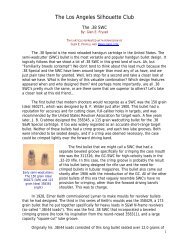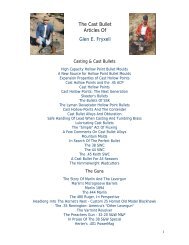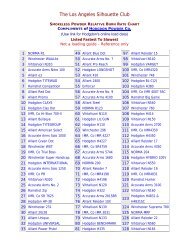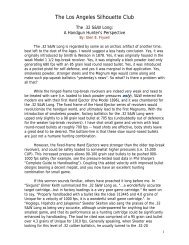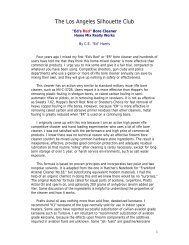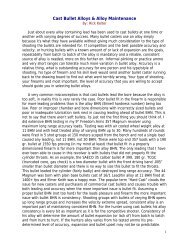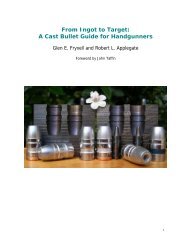You also want an ePaper? Increase the reach of your titles
YUMPU automatically turns print PDFs into web optimized ePapers that Google loves.
opposite bank. Now separated from the rest of the herd getting a clear shot was<br />
easy, and I put a 300 grain HP right through the middle of his ribs, flattening him<br />
instantly. He collapsed and tumbled down into the bottom of the creek, wedging<br />
himself in between two large rocks. With him down at the bottom of that creek,<br />
it soon became apparent that my original estimate of “about 250 pounds” was<br />
off by a bit, and this guy was more like 300 lbs. Clark came in with his 4-<br />
wheeler, and it took the three of us 30-40 minutes to get that hog out of that<br />
creek channel, and loaded up onto his trailer. I shudder to think what that job<br />
would have been like without Clark’s 4-wheeler and trailer.<br />
Back at the skinning shed we were able to piece together what had<br />
happened with my hog. Plain and simple, I jerked the trigger on that first shot,<br />
and pulled it low and a little left. It had gone in below the ribs and just creased<br />
the belly, then hit the far side (left) hindquarter, where just by pure luck it had<br />
hit the femoral artery (hence the strong blood trail). This wound would have<br />
eventually proven fatal, but only by random luck. The second shot had indeed<br />
gone low (just as I had called), but it had hit a rock and ricocheted straight up<br />
vertically into the left “armpit” of the boar, and traveled up in between the<br />
shoulder muscles and the ribs, doing substantial damage to a lot of meat in the<br />
ribs, but not doing much that would hasten porky’s demise. The third shot<br />
entered the center of the right side ribcage and exited in the rear portion of the<br />
ribs on the left side. The 300 grain cast HP expanded well, did extensive damage<br />
to both lungs and punched right on out the other side.<br />
Clark had most of the skinning<br />
chores done before we got back down to<br />
camp (he’s fast with a knife!). It got down<br />
below freezing that night, so both the yak<br />
and the hog chilled down quite nicely.<br />
Dinner that night was pan-fried steaks<br />
(much too windy to grill over the campfire<br />
like we had planned) and salad. Sleep<br />
came easily for me that night.<br />
Old Model SBH<br />
After a hearty breakfast the next morning we got Bob loaded up and on the<br />
road, and then I sat down and butchered my hog for the trip back home. On this<br />
trip I was using a Dozier Professional Skinner that I had just bought from a<br />
friend of mine down in Texas. For many years I have heard of the reputation of<br />
Bob Dozier’s knives and the exceptional edge retention resulting from his heat<br />
treatment of D2 steel to 60-61 Rc. I’ve always wanted to work with one, but had<br />
just never “pulled the trigger” and bought one. Well, Mark offered one up for<br />
sale earlier this spring, and it was even the model that I favored, so I just<br />
decided that the time had come, and mailed him the check. The Dozier<br />
Professional Skinner performed beautifully while I was butchering this hog. I<br />
never once had to touch up the edge, and it still shaves after cutting all that<br />
pork. This is a magnificent knife!<br />
OK, there is one thing that I’m not real crazy about, and that’s the Kydex<br />
10



